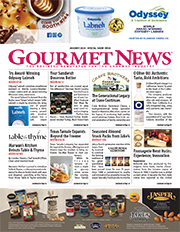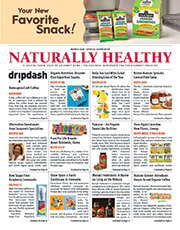Pairwise Develops World’s First Seedless Blackberry
 Pairwise, a company pioneering genetics-based innovation in food and agriculture, has developed the world’s first seedless blackberry. Created using the company’s proprietary Fulcrum Platform, a complete suite of novel tools for CRISPR application in plants, this is the first time seedlessness has been achieved in any caneberry.
Pairwise, a company pioneering genetics-based innovation in food and agriculture, has developed the world’s first seedless blackberry. Created using the company’s proprietary Fulcrum Platform, a complete suite of novel tools for CRISPR application in plants, this is the first time seedlessness has been achieved in any caneberry.
“We are thrilled to share this breakthrough achievement from our talented R&D team. Pairwise scientists have used their deep knowledge of plant genetics, broad suite of CRISPR tools, and multiplex editing techniques to eliminate the hard pits in berry fruit, creating soft, small seeds like those found in grapes and watermelon that are commonly labeled as seedless,” said Ryan Bartlett, Pairwise chief technology officer. “The result is the first seedless blackberry in the world. We expect that this trait will not only transform the blackberry market, but it also lays the groundwork for accelerated progress in removing seeds and pits in many other fruits such as cherries.”
Recent innovations in produce have been rapidly adopted due to the significant benefits they provide consumers, such as improved flavor, consistency, and convenience.
“The berry variety we edited is consistently sweet year-round and holds up well during shipment; now, consumers will have the option to choose a nutritious blackberry without seeds that also reliably delivers great flavor and quality,” said Haven Baker, Pairwise co-founder and chief business officer. “Blackberries are a snackable fruit with significant health benefits; however, data indicates that more than 30 percent of berry buyers do not like the seeds, and many more do not even buy the fruit because of the seeds.”
In addition to creating the first seedless caneberry, Pairwise has successfully edited the same variety to eliminate thorns and create a more compact plant that delivers benefits for harvesters, growers and the environment. The thornless and compact traits enable more efficient fruit harvesting and improved productivity and profitability for growers. The new compact trait means the plants are smaller and can be planted at a higher density per acre. Early data from Pairwise-led trials indicate the potential to greatly increase yield per acre while necessitating only a minimal increase in inputs – meaning the water and land used per crate of fruit harvested decreases significantly.
“Our high-density compact and thornless traits contribute to a more sustainable food system. The absence of thorns and reduced height of the compact plants allow berry harvesters to better access the fruit and leave less on the plant, reducing food waste and further improving the growers’ economics. With the precision of CRISPR, we’re able to develop these thornless and compact traits without sacrificing consistency in flavor and quality for consumers,” said Baker. “We’re excited to advance these berries into the next phase of product development, including outdoor field trials, as we work toward scaling up and making them available to the public in a few years.”
“A key challenge in our food system is helping people eat more high-quality, healthy foods. As part of our drive to increase the consumption of fruit and vegetables, we’re working to provide consumers with new, highly nutritious food options with improved flavor and convenience,” said Tom Adams, Pairwise Co-Founder and CEO. “With a deep understanding of the plant genome, an accurate, efficient, and scalable process, and streamlined pathway to commercialization, we are not only creating new products with our proprietary CRISPR technology, we are creating a new era of innovation in agriculture.”
Learn more about Pairwise and its Fulcrum Platform here.
Pairwise is pioneering the application of CRISPR technology in food and agriculture. The company brings together leaders in agriculture, technology, and consumer foods to harness the transformative potential of new genomics technologies to create innovative new products. Pairwise is working to develop new varieties of crops, and to partner with organizations that seek to deliver innovation across the plant-based economy. Backed by industry leading investors Deerfield, Aliment Capital, Leaps by Bayer, and Temasek,
Pairwise raised $90 million in a successful series B funding round in February 2021, bringing total fundraising to $115 million. The company was founded by Chief Executive Officer Tom Adams and Chief Business Officer Haven Baker, with scientific co-founders J. Keith Joung, Lead Translator at Arena BioWorks; David Liu, Director of the Merkin Institute of Transformative Technologies in Healthcare, and Vice-Chair of the Faculty at the Broad Institute of Harvard and MIT; and Feng Zhang, McGovern Investigator and a professor at MIT. For more information, visit Pairwise.com, and learn more about the differentiating Pairwise Fulcrum Platform here.
For more news of interest to the produce industry, subscribe to Gourmet News.
IFCO Launches Marina, Digitally Enabled Reusable Fish Crate
 IFCO, a leading provider of reusable packaging containers, has launched Marina, the smart reusable IFCO Fish Crate. Designed in close collaboration with the fishing industry, Marina brings greater protection, efficiency and sustainability to the fresh fish and seafood supply chain. Featuring track-and-trace Bluetooth Low Energy tags and QR codes, the Marina Fish Crate enables real-time data collection, improving the cold chain management of fresh and chilled products along the entire fish and seafood supply chain, from ship to all points of sale.
IFCO, a leading provider of reusable packaging containers, has launched Marina, the smart reusable IFCO Fish Crate. Designed in close collaboration with the fishing industry, Marina brings greater protection, efficiency and sustainability to the fresh fish and seafood supply chain. Featuring track-and-trace Bluetooth Low Energy tags and QR codes, the Marina Fish Crate enables real-time data collection, improving the cold chain management of fresh and chilled products along the entire fish and seafood supply chain, from ship to all points of sale.
Single-use expanded polystyrene boxes can break down into microplastic pollution and contaminate the marine food chain and human health, so governments around the world are increasingly tightening regulations and introducing EPS bans. As a result, many producers, wholesalers and retailers in the fishing industry have made eliminating EPS boxes and switching to sustainable packaging a priority. The IFCO SmartCycle pooling system ensures the switch to Marina is simple, seamless and sustainable.
Nestable when empty, securely stackable when full, the Marina Fish Crate saves space on ships and on shore, cutting carbon emissions in transport and improving handling conditions. Its uniform dimensions are compatible with existing supply chains, automated logistics systems and the IFCO Plastic Pallet Dora.
Francesca Amadei, vice President Southern Europe at IFCO, highlights the unique advantages of the Marina Fish Crate: “Marina is the result of intense collaboration across the fishing industry. We’ve taken on board the unique demands of every step of the fresh fish and seafood supply chain in our R&D efforts.”
The Marina Fish Crate offers a sustainable and efficient complete packaging solution. Like all IFCO Reusable Packaging Containers (RPCs) Marina uses fewer natural resources throughout its life cycle compared to single-use packaging. And, unlike conventional fish boxes made from expanded polystyrene (EPS) that are typically sent to landfills or end up as marine pollution, Marina is 100% recycled at the end of a long service life into new products.
Inigo Canalejo, vice president ESG and strategic marketing at IFCO, highlights the long-term benefits of Marina for the fishing industry and the planet:
“We see it as our responsibility to improve the environmental sustainability of every category of the fresh grocery supply chain. Our Marina Fish Crate is a smart, innovative packaging solution that will have a lasting positive impact on the fresh fish and seafood supply chain. We’re proud to have designed a sustainable and more efficient alternative to harmful expanded polystyrene containers.”
For more news of interest to the seafood industry, subscribe to Gourmet News.
Too Good to Be True? Tillamook iScreen Sells Out Fast
If you know June 7 is National Chocolate Ice Cream Day, it’s likely because you’ve heard of the new Tillamook Chocolate Collection and the amazing news that the company launched Tillamook iScreen, which purportedly hides the ice cream from would-be ice cream thieves. The iScreens went on sale June 7, but sold out within hours, according to the company website. There is, however, a contest to win the iScreen, an ice cream scoop and coupons to guy the new chocolate ice creams.
By now, the secret is out about the new, decadent Tillamook Chocolate Collection, with ice cream lovers coast-to-coast digging into the four new flavors from America’s fastest growing scoopable ice cream brand. The collection is so rich and delicious, you may not want to share a scoop with anyone else, from partners to siblings to roommates…even those kiddos. And, you wouldn’t have to share, if only you could disappear it before they do. Enter the new Tillamook iScreen, a high-tech solution to protect your Chocolate Collection Ice Cream by making it hide in plain sight (say whaaaaat?), for sale on Tillamook.com on June 7 to celebrate National Chocolate Ice Cream Day.
With the Tillamook iScreen, you have a personal privacy shield that uses cutting-edge technology to make your Tillamook Chocolate Collection Ice Cream disappear right before your eyes (editor’s note: this is not magic, but it is magical). The Chocolate Collection Ice Cream carton becomes invisible to the naked eye as it sits just behind the Tillamook iScreen in your freezer, so it’s kept safe and ready to eat, just for you. No more precious scoops lost to those pesky freezer grazers who may be on the prowl for a sweet treat.
How, exactly, does the Tillamook iScreen hide your Tillamook ice cream in plain sight? We’re glad you asked: the Tillamook iScreen acts as an invisibility shield, using R&D that spans half a decade. The magic happens with materials made from lenticular lenses, which use tiny ridges to bend light, tricking the eye to make what’s behind the shield, simply, disappear. See the Tillamook iScreen in action and get your own at Tillamook.com for $19.99 starting June 7, just in time to celebrate National Chocolate Ice Cream Day.
Have you tasted the new Tillamook Chocolate Collection Ice Cream yet? Created for lovers of chocolate, the new collection is made with extra cream (Tillamook uses more cream to achieve a higher milkfat than is required) and 45 percent more cocoa than our classic chocolate ice cream flavors, creating richer, darker, decadent flavors that provide maximum delight by the spoonful. Get your chocolate craving fix with four flavors, including:
- German Chocolate Cake: This dreamy dark chocolate ice cream is mixed with a brown sugar coconut swirl, chopped pecans, and pieces of chocolate cake.
- Brownie Batter: Fantastically fudgy, this extra creamy ice cream is chock-full of dark chocolate flavor and brownie bites.
- Dark Chocolate Cookies & Cream: There’s nothing cookie-cutter about this new dark chocolate ice cream made with dark chocolate cookie pieces and flecks of cream filling.
- Chocolate Hazelnut: Go nuts for rich chocolate with this dark chocolate ice cream with chopped hazelnuts and a hazelnut butter ribbon.
“We know Tillamook fans everywhere are crazy for the new Chocolate Collection and will go to great lengths to keep their freezers stocked with the goods – as they should,” said Kate Boltin, Vice President of Marketing at Tillamook. “Some people are kind enough to share a spoonful here or there, while others are not, and that’s OK too. Honestly, that’s why we created the Tillamook iScreen, to keep unwanted spoons out of your Tillamook ice cream, so it stays, well, yours.”
The Tillamook iScreen was developed in partnership with HELO, There You Have It 3D, and Leo Burnett. To learn more about the Tillamook iScreen, visit tillamook.com/products/ice-cream/chocolate-collection. Tillamook ice cream, including the Chocolate Collection, is available across the country at Kroger, Albertsons, Safeway, Publix, Ahold Delhaize, and many other grocery stores. Find it at a store near you at FindTillamook.com and learn more at Tillamook.com.
For more news of interest to the dairy industry, subscribe to Gourmet News.









